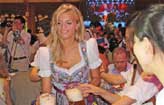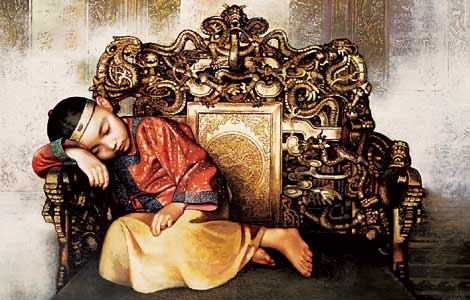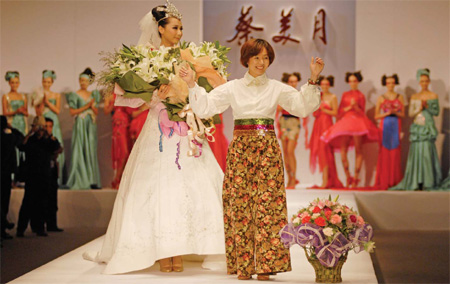Economy
The Chinese character
Updated: 2011-08-12 12:35
(China Daily European Weekly)
|
|
Designer basks in a growing number of young people who buy their own wedding dresses
In the world of fashion, a well-known name on a garment can be the key to success. But what makes the works of the wedding dress designer Tsai Meiyue stand out is that the signature she leaves on her works is in Chinese characters. Some of her business partners in Western companies have suggested she ditch the Chinese in favour of the Latin alphabet to give her brand bigger Western exposure, but Tsai refuses to budge.
"My wedding dress is Chinese styled, and Chinese characters represent the Chinese style," she says. "I think they are a perfect combination."
For Tsai, born in Taiwan, making wedding dresses with a Chinese touch has been a lifetime pursuit.
She now has seven shops throughout China, each garment with its unique design and fabric, and ranging in price from 500 yuan (54.7 euros) to 10,000 yuan. But there is one constant: the Chinese look.
That has not stopped her looking elsewhere for inspiration. For example, she believes that combining Chinese elements with a white wedding gown will bring out the most alluring aspects of those elements.
Some people regard traditional Chinese things as old-fashioned, she says, but she does not see it that way and is happy to dip into 5,000 years of history in her quest for beauty.
She is enchanted by ancient China's architecture, particularly engraved patterns on windows and doors, and has been trying to add these patterns to her wedding dresses. She also uses Chinese embroidery, relying on clothes woven by her own factory.
"Chinese embroidery can bring Chinese flavors to wedding dresses, so they can be more attached to Chinese consumers, and in recent years they have raised eyebrows internationally.
"I am sure dresses with traditional Chinese elements will lead world fashion trends for wedding dresses."
For the moment, her goal is to let every Chinese bride have a wedding dress adorned with the beauty of Chinese elements.
"Almost 90 percent of the world's wedding dresses come from China, but we do not have a brand of our own. China's embroidery techniques are far more advanced than those of Western countries. Why should we be satisfied with only doing OEM (original equipment manufacturing)?"
Tsai came to the mainland in 1992 hoping to build a Chinese wedding dress brand. At the start she focused on overseas markets.
"At that time, almost no woman on the mainland had the idea of having her own wedding dress, and my factory in Xiamen, Fujian province, was only a manufacturing center for exporting," she says.
It was not until 1996 that she turned her eye to Chinese consumers, when wedding dresses were gaining popularity in China. But Tsai says that in those days most brides rented their wedding dress, rather than buy it.
"Once a reporter from The New York Times asked me whether Chinese women were too poor to afford a wedding dress. In their culture, renting a wedding dress is unimaginable.
"I said it was not that they do not have the money. It was simply because they are not fully aware of the wedding dress culture."
It was then that Tsai's eyes opened to the market potential of the mainland. She felt that with proper promotion, Chinese women would eventually understand the importance of having their own wedding dress.
Things were not easy at the start, and she lost money, but she picked up the pieces and is now thriving in a market in which the mindset of Chinese women has changed radically. "With increased spending power, an increasing number of brides in China are accepting the idea that the wedding dress is one of the important witnesses of their marriages," she says.
Unlike some other fashion brands that have tagged high-end labels to their products, Tsai says she cares more about selling her dresses to a wider range of customers.
"I did not set a certain target group. I want more Chinese brides to afford a favorite wedding dress."
Tsai was named a China Top 10 Designer at China Fashion Week from 2004 to 2006 and she has become a figurehead in wedding dress designing in the country. Her collections have been photographed in China and elsewhere. Her designs are often mentioned in the same breath as those of Vera Wang, Oscar de la Renta and Yumi Katsura.
Her seven shops sell only her works, which are sold in other shops as well. She is coy about her shops' revenue.
Now Tsai has her eye on new horizons. She wants to broaden her company's activities to include wedding photography and ceremony planning.
"One piece of favorite wedding dress, one memorable picture and one unforgettable wedding ceremony is what I think matters to brides. And every bride should enjoy the process of producing these memories.
"But the industries are not well-integrated, so many people think the procedure is tiresome and annoying. Of course, wedding dresses will still be our core business, and I do hope my design can stimulate more talented young Chinese designers to devote themselves to the wedding dress world."

Specials

Star journalist leaves legacy
Li Xing, China Daily's assistant editor-in-chief and veteran columnist, died of a cerebral hemorrhage on Aug 7 in Washington DC, US.

Beer we go
Early numbers not so robust for Beijing's first international beer festival

Lifting the veil
Beijing's Palace Museum, also known as the Forbidden City, is steeped in history, dreams and tears, which are perfectly reflected in design.
